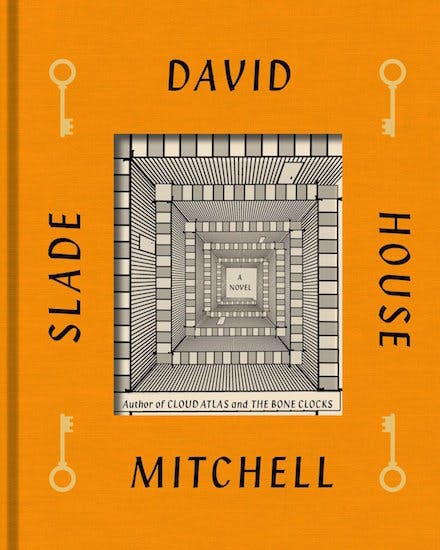
Twitter seems like the kind of place a novelist like David Mitchell would feel at home; it’s a platform that allows for shifting identities, where new accounts appear in unexpected contexts, only to slip away and return with a different name and face. Mitchell has a proven fondness for interpenetrating planes of narrative, crosshatchings of history, fiction, and speculation that hint at deeper truth, and Twitter lets you experiment with these simultaneities, or at least watch them play themselves out.
It’s not surprising, then, that Mitchell’s newest novel, Slade House, began life as a series of tweets. In April of 2014, Mitchell created @david_mitchell, a new personal account, in order to spin the 280-tweet short story, “The Right Sort.” In the story, a teenage boy named Nathan Bland accompanies his mother to a mysterious house in Slade Alley, the home of Lady Briggs, and has a frightening hallucination that he attributes to a valium he stole before the outing. Although Mitchell’s British publisher said the author was not planning to have a new book for a few years, “The Right Sort” waylaid him: “Accustomed to having his next few novels thoroughly mapped out, David Mitchell was not expecting to be ambushed by this one, but it proved irresistible,” a spokesperson for the publisher told the Guardian last year. The 280-tweet story, with some tweaks, became the opening of a slim 238-page book.

A few surnames have shifted—Lady Briggs is now Lady Grayer and narrator Nathan Bland has morphed into Nathan Bishop—and so has the narrator’s voice. On Twitter, Nathan sounded a little like Jason Taylor, the 13-year-old protagonist of Mitchell’s 2006 book Black Swan Green: astute, disaffected, and painfully aware of other people’s opinions. Perhaps the author, who has always pinballed from narrator to narrator, didn’t want to repeat himself—the Nathan of Slade House now seems to be on the autism spectrum, a perspective that Mitchell, whose son is autistic, handles deftly. But the minimal plot of “The Right Sort” is preserved, though the novel takes a much darker turn after the point where the Twitter story leaves off. And at the center of both works—as well as the next four parts of the novel, which leave Nathan and his mother to follow four other narrators—are Slade House and its supernatural inhabitants, who turn out to feed on human souls.
The eponymous haunted house is itself a masterpiece of fantasy architecture, a mansion and grounds cupped inside a city block technically too small to contain them. The house can only be reached through a small iron door in the unnervingly narrow and grim Slade Alley, but once you’re through the wall, the cramped space unfurls into a charming garden and an elegant manor. It’s a fairly common fantasy trope—one part Tamson House from Charles de Lint’s Moonheart, another part Room of Requirement from Harry Potter, with a little menacing from the Mark Z. Danielewski’s cryptic House of Leaves thrown in. But in Slade House it nonetheless feels fresh, like seeing the theme from a recurring dream reinterpreted in someone else’s work of art.
Mitchell’s books often employ massive jumps in time, space, and genre. His 2004 magnum opus Cloud Atlas, for instance, leapfrogs from 1850 to the near past, then to the present day and the far future, beginning as historical fiction and becoming thriller and farce before moving into dystopian and finally post-apocalyptic sci-fi. By contrast, Slade House is relatively sedate; its five sections occur a modest and regular nine years apart, and the action barely leaves the mansion’s grounds. The house exerts a powerful gravitational pull on both the characters and the narrative. This is partly because of the demands of the story: Slade House is the permanent home of two immortals, whose bodies are trapped in a pocket of timelessness within the house, and other characters are drawn to it precisely like flies into a web. But I suspect it’s also because Slade House, the building, has many of the best qualities of a Mitchell novel—it is beautiful, protean, labyrinthine, impenetrable to many, and never fully explained—whereas Slade House, the book, just doesn’t quite measure up.
Mitchell’s most ambitious interlinked works—like Cloud Atlas, and his first novel, Ghostwritten (1999)—are not only mysterious but robustly mysterious, laden with the kind of portentousness that hints at multiple explanations without offering anything so prosaic as an answer. Consider first few seasons of Lost: the increasing atmosphere of strangeness and significance, the feverish conversations with your friends about what it all meant. Lost wound up proffering flabby explanations that struggled to tie everything together, but a book like Cloud Atlas doesn’t kneecap itself that way; Mitchell’s waveforms do not collapse, they propagate.
Even a straightforward-seeming Bildungsroman, like his 2006 novel Black Swan Green, takes part in this robust mystery, since Mitchell has a habit of seeding his characters into his other works—it’s his signature move, like Alfred Hitchcock’s cameos. Black Swan Green spans only a year, stays put in space and genre, and merely hints at the unexplainable, but it’s tied to Mitchell’s more enigmatic work by appearances from characters the reader met in Cloud Atlas and Ghostwritten, or would later meet in his 2014 novel TheBone Clocks. Perhaps these walk-ons started as a gimmick, but they also imply that Mitchell’s works take place in a consistent universe.
This multifoliate—and eventually multivolume—mysteriousness has always been at the center of my love for Mitchell’s work. I remember discussing Cloud Atlas in a bar with my best friend after we read it, the first Mitchell for us both; we felt as though we were working out Fermat’s last theorem, taking apart a complex machine, and trying to decode the Voynich manuscript all at once. We explained it, complicated the explanation, got drunker, made a new solution, promptly forgot what our answer had been—it didn’t matter, because the experience of thinking deeply and glimpsing a pattern and getting excited was the point. (I also remember our conversation after realizing that Black Swan Green, the second book of his we both read, featured a Cloud Atlas cameo. Fortunately, I have a digital record of that one, it went like this: “Aaaaaaaaaaaaah!”)
It’s a rare writer who can build that kind of evocative ambiguity without grasping at the easy crutch of a solution. Mitchell wasn’t the first author I encountered who could do it, but it shot him to the top ranks of my pantheon of robustly mysterious novelists, which included Salman Rushdie, Italo Calvino, and the underappreciated Serbian novelist Milorad Pavic.
The Bone Clocks, Mitchell’s last novel before Slade House, was a towering book in its own right, but it also represented Mitchell’s first attempt to define the terms of his world. This had its benefits—you started to see the musculature pulling the Mitchellverse into place. At the same time, though, it eroded the robustness of the mystery, its ability to allow multiple interpretations without collapsing. The shadowy figures who animated his books are brought into the light: they are the Anchorites, followers of the Shaded Way, an ancient sect of soul-devouring immortals, and the Horologists, a benevolent clade of repeat reincarnators. It’s implied that they’ve been warring around the edges of all of Mitchell’s books, all the way back through time, but here their histories, methods, and intentions are front and center. With Bone Clocks, we started to find explanations, and explanations are the death of intrigue.
In Slade House, the ratio of explanation to enigma approaches one to one. Its strangeness is beautifully wrought at first, but its strangeness doesn’t stay strange. Everything is explicated, often several times, and everything finds its place within the cosmology established in the previous book. There’s even a long expository biography of the soul-stealing antagonists and their relation to the dark forces in The Bone Clocks. Slade House is slight, sometimes repetitive, and much less ambitious than Mitchell’s other works. It feels like exactly what Mitchell’s publisher suggests it is: a diverting story drawn out into an unexpected novel, a doodle drawn by a genius. It feels, quite frankly, like very good Bone Clocks fanfiction.
This is not to say that Slade House isn’t worth reading—there’s a whole contingent of Mitchell fanatics for whom “very good Bone Clocks fanfiction” sounds like the highest praise. The book offers a chance to see Mitchell inhabit four new narrators, which alone is worth the price of admission; he’s like a sumi-e master of voice, sketching beautifully-detailed characters with a few lightning-fast flicks of the brush. Both Bone Clocks and Slade House feature immortals who cheat death by piggybacking on a human body. For most writers this would be a fantasy trope, but for Mitchell it may be a fictionalized depiction of how he feels as an author: a quiet passenger observing and directing a vibrant, unique human host. Few can do it so often so well.
Those unfamiliar with Mitchell’s oeuvre will get the same benefits, plus a measure of surprise at a twist that Bone Clocks fans will see from afar. They may feel mystified when talk turns to “horologists” and “shaded ways,” but nascent Mitchell readers won’t mind being mystified. Shorter than Mitchell’s masterworks, but hinting at his grander themes and structures and the shape of the universe he’s built, Slade House could be an adequate gateway drug.
I do relish the interconnectedness of Mitchell’s works. (I have a theory, for instance, that Meronym is Marinus, and if that sentence made you gasp, well, you’re Slade House’s target audience.) But historically, more than anything else, I’ve relished how much work they make the reader do alone—how much work they allow the reader to do. I wouldn’t go so far as to say it feels like a novel written on Twitter, which would be incredibly cruel and also not true, but as someone who fell in love with Mitchell’s ambiguity, reading Slade House feels like a print devotee scanning social media: it’s a little lazy, a little repetitious, a little “what I ate for lunch: other people’s souls.” I found the experience of reading Slade House bittersweet, not because it was unsatisfying, but because it wasn’t unsatisfying enough.